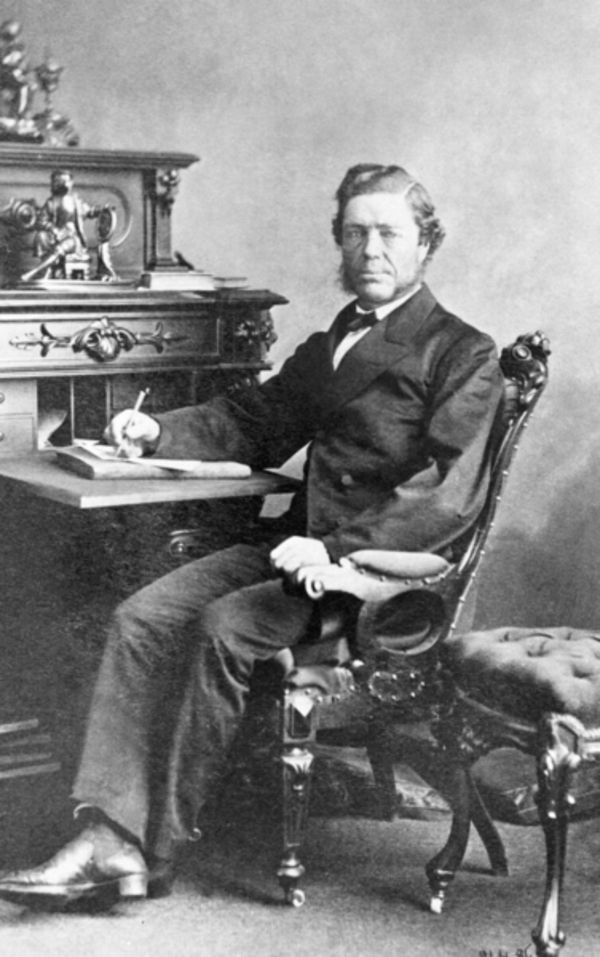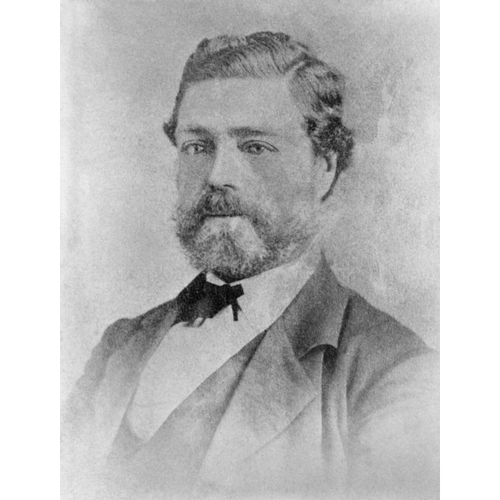
Source: Link
HARDISTY, WILLIAM LUCAS, HBC fur-trader; b. c. 1822 probably at Waswanipi House (Que.), on Waswinipi Lake in the Rupert River district, second child of HBC Chief Trader Richard Hardisty and Margaret Sutherland, and brother of Richard Charles Hardisty; m. Mary Allen, and they had three sons and two daughters; d. 16 Jan. 1881 at Lachine, Que.
William Lucas Hardisty was educated at the Red River Academy, and in 1842 entered the Hudson’s Bay Company as a post master (a rank below that of clerk). He was posted to the Mackenzie River District, and in 1843 was sent to Frances Lake (Yukon) to serve under Robert Campbell*. The next summer Hardisty was left in charge of the post during the absence of Campbell who, upon his return, reported: “the Fort & every thing about it in the best possible order . . . I could not be more highly satisfied . . . .”
In November 1844 Hardisty left Frances Lake for Pelly River Post to collect provisions and to trade with the “gens des Couteaux,” a branch of the Salish, and other local bands. After a “highly satisfactory” trading trip he was obliged to return to Frances Lake in January 1845 because, as Campbell wrote, of “our constant enemy [-] want of provisions.” In March Hardisty again attempted to trade with the Indians of the Pelly River area, but lack of food forced his return to Frances Lake in April.
In 1846 Hardisty was once more left in charge of Frances Lake during Campbell’s absence. Illness in 1847–48 forced him to winter at Fort Simpson (N.W.T.). Recovered by June 1848, he helped Augustus Richard Peers construct new buildings on the Peel River, taking charge there while Peers travelled to Fort Simpson. In November Hardisty took over the “lonely abode” of Lapierre’s House at the junction of the Bell and Rat rivers, an outpost on the route to Fort Yukon (Alaska). During the summer of 1849 he again assisted at Peel River, and then took charge during Peers’s absence. In September Hardisty and his men were surprised by the arrival of Lieutenant William John Samuel Pullen and 14 others from the ship Plover who had travelled down the Mackenzie River in search of Sir John Franklin*. Food being short at Peel River, the visitors soon left to winter at posts that were better supplied.
In 1851 Hardisty left Lapierre’s House to replace Alexander Hunter Murray* in charge of Fort Yukon. That winter Hardisty was successful in opening trade with new Indian groups, receiving “warmest Commendations” from his superior James Anderson*. Hardisty applied for a leave of absence for 1853–54, apparently having in mind some private business with retired HBC officer George Gladman*, but Governor Sir George Simpson* responded by warning that as a clerk Hardisty did not have tenure, adding that “the withdrawal of clerks from duty on the ground of ill health private business and other reasons more frivolous . . . is attended with serious inconvenience.” Thus denied sure readmittance to the HBC, Hardisty kept his Fort Yukon position.
Situated among the Kutchin or Loucheux Indians, themselves active traders, Hardisty continued to please his superiors and was promoted chief trader in 1858. He greatly encouraged trade and experimented with substituting direct trade for the system of having the Indians accumulate debts to the company. In 1859–60, after taking charge of Fort Resolution on Great Slave Lake, he assisted Robert Kennicott of the Smithsonian Institution in collecting birds, thus beginning a lengthy affiliation with the institution as a contributor of specimens and later as an author; his detailed account of the Loucheux Indians was published by the Smithsonian in 1867.
After spending 1860–62 at Fort Liard (N.W.T.), Hardisty moved to Fort Simpson and took charge of the Mackenzie River District, replacing Bernard Rogan Ross*. Pressed by the need to accommodate missionaries, by threats of free traders, by provisioning problems, and, in 1864–66, by widespread syphilis, scarlet fever, and measles among the Indians, Hardisty earned a commendation for good management in difficult times. He was particularly praised for his “judicious and well timed” change in the debt system along the lines of his Fort Yukon experiment. In 1868 Hardisty was promoted chief factor.
From 1869 until retirement Hardisty remained in charge of the Mackenzie District. Following the American purchase of Alaska he was obliged to cope with the American take-over of Fort Yukon in the fall of 1869; the HBC men there were ordered to cease trading or face penalties for smuggling. By November 1870 the Mackenzie trade was beginning to show a deficit, and Hardisty wrote to Donald Alexander Smith*, his sister’s husband, that the company appeared “to have lost ground entirely in that quarter. The Americans are carrying all before them, they have goods similar to our own which they are selling more than 200 p cent cheaper than we can afford to do – also supply the Indians gratuitously with Tea, Sugar, Rice, Raisins & Flour.” Hardisty consequently urged the division of his district into two, to ease management and to enable the company to oppose free traders more effectively. He also proposed periodic trading trips to the Indians of the Yukon and the use of the Bering Strait as a shipping route for goods being brought into the area.
Hardisty retired from the HBC in 1878, and after passing the winter of 1878–79 in Winnipeg, he took up residence in Lachine. He died there on 16 Jan. 1881.
W. L. Hardisty was the author of “The Loucheux Indians,” Smithsonian Institution, Annual report (Washington), 1866: 311–20.
AO, Moose Factory Anglican and Methodist missions, 1780–1906 (mfm.). PAM, HBCA, A.34/1: f.122; A.36/7: ff.62–64; B.85/a/13: f.7; B.200/b/15: f.21; B.200/b/17: f.4; B.200/b/20: 9, 21, 50; B.200/b/21: f.13; B.200/b/22: f.37; B.200/b/23: f.12; B.200/b/26: f.30; B.200/b/28: 3, 108–12; B.200/b/30: 6, 16; B.200/b/32: 5; B.200/b/33–36; B.200/b/38: 42, 100, 109; B.200/c/1: f.37; D.4/82: ff.175–78. PAC, MG 19, A29; D12. HBRS, XIX (Rich and A. M. Johnson). [John Rae], John Rae’s correspondence with the Hudson’s Bay Company on Arctic exploration, 1844–1855, ed. E. E. Rich and A. M. Johnson (London, 1953). Montreal Herald and Daily Commercial Gazette, 18 Jan. 1881. Winnipeg Daily Times, 18 Jan. 1881. W. J. Healy, Women of Red River: being a book written from the recollections of women surviving from the Red River era (Winnipeg, 1923). [H. ] B . Willson, The life of Lord Strathcona & Mount Royal, G.C.M.G., G.C.V.O. (1820–1914) (London and Toronto, 1915). G. L. Nute, “Kennicott in the north,” Beaver, outfit 274 (September 1943): 28–32.
Cite This Article
Jennifer S. H. Brown, “HARDISTY, WILLIAM LUCAS,” in Dictionary of Canadian Biography, vol. 11, University of Toronto/Université Laval, 2003–, accessed December 22, 2025, https://www.biographi.ca/en/bio/hardisty_william_lucas_11E.html.
The citation above shows the format for footnotes and endnotes according to the Chicago manual of style (16th edition). Information to be used in other citation formats:
| Permalink: | https://www.biographi.ca/en/bio/hardisty_william_lucas_11E.html |
| Author of Article: | Jennifer S. H. Brown |
| Title of Article: | HARDISTY, WILLIAM LUCAS |
| Publication Name: | Dictionary of Canadian Biography, vol. 11 |
| Publisher: | University of Toronto/Université Laval |
| Year of publication: | 1982 |
| Year of revision: | 1982 |
| Access Date: | December 22, 2025 |




